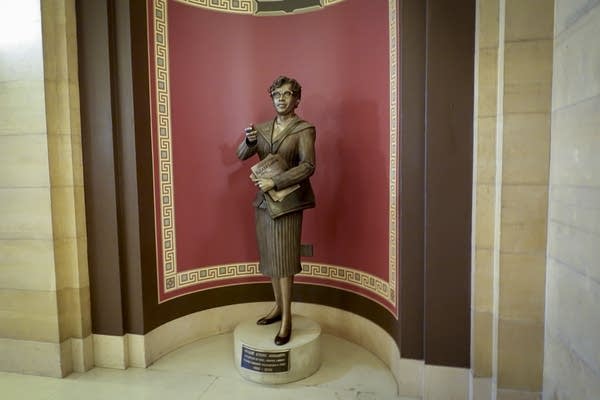'The woman of the century': Nellie Stone Johnson honored with Minnesota Capitol statue

Go Deeper.
Create an account or log in to save stories.
Like this?
Thanks for liking this story! We have added it to a list of your favorite stories.
Minnesota Gov. Tim Walz on Monday, along with labor and community leaders unveiled a statue depicting labor and civil rights activist Nellie Stone Johnson at the state Capitol.
It marks the first time that an actual woman, and a Black Minnesotan, is set to be memorialized in a statue there. And it’s believed to be the first statue depicting a Black woman in any state capitol building.
Stone Johnson was a labor leader in the 1930s and 1940s who went on to become the first Black person elected to a citywide office in Minneapolis when she won a seat on the city’s library board.
While there are dozens of statues scattered around the grounds of the Minnesota Capitol that pay tribute to men, there hasn’t been a representation of a woman previously. For more than a century, the only representations of women in Capitol statues have been symbolic of broader ideas, not made to depict female figures in history.
Turn Up Your Support
MPR News helps you turn down the noise and build shared understanding. Turn up your support for this public resource and keep trusted journalism accessible to all.
Within the Capitol, there are two women honored with plaques: Dr. Martha Ripley and Clara Ueland. Lt. Gov. Peggy Flanagan said the statue will help more Minnesotans to see themselves represented.
“Now when our students are visiting the Capitol, they are going to see and learn about the legacy of Nellie and all she represents. They’re going to see themselves reflected in the people’s house in a way they haven’t before,” Flanagan said. “Thank you for this opportunity for every little girl to know that she has a place and space in this building in whatever role she chooses.”
Stone Johnson also served on the Minnesota State University Board and the Minnesota State Colleges and Universities Board of Trustees. And she worked with national civil rights leaders and former Vice Presidents Walter Mondale and Hubert Humphrey to shape their policies.
“She was a doer,” former Minnesota Attorney General Skip Humphrey said. “And if you look at the record that she has, that she accumulated, it was about getting the job done. And she helped drag this state and frankly, this nation forward. We need more of that.”

Educators, labor union leaders and former lawmakers remembered Stone Johnson’s drive to help people get access to education and good jobs. Today, there is a scholarship program named for Stone Johnson that offers financial support to people of color and Indigenous people who are union members or are related to union members and plan to attend one of the colleges or universities in the Minnesota State system.
Former State Rep. Joe Mullery said he first sought to get legislative approval to commission the statue in the 1980s but it took decades to finally get the okay from the Minnesota Legislature. He said he hoped to bring a woman and a person of color into the Capitol’s works of art because mostly white men in political offices were represented there. In 2014, lawmakers signed off and the effort to enshrine Stone Johnson got underway.
“I've called her the woman of the century in Minnesota, because she accomplished so much for so many varieties of people – people of color, workers, union members, women, educators, farmers – the list goes on,” Mullery said. “And while she became a leader on extremely varied initiatives, she told me over and over that they all sprouted from her clarion call that what everyone needs is an equal opportunity to a good job, a good education and a good job.”
Sculptor Tim Cleary created the life-size statue that shows Stone Johnson holding Farmer Labor party publications.
William Patterson, Stone Johnson’s great nephew, attended the ceremony along with members of his family and they posed for photos with the new statue. Patterson and his family said that they remembered Stone Johnson’s ability to bring people together.
“She’s just a motivator, she knew how to push people’s buttons, she knew how to get response, she knew how to bring people together is what she knew how to do,” Patterson said. “It didn’t matter — Black people, white people, farmers, city people — she knew how to build coalitions and get things done. And she did it for 70 years.”
Dear reader,
Political debates with family or friends can get heated. But what if there was a way to handle them better?
You can learn how to have civil political conversations with our new e-book!
Download our free e-book, Talking Sense: Have Hard Political Conversations, Better, and learn how to talk without the tension.



